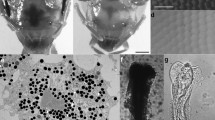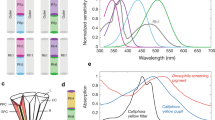Summary
-
1.
Intracellular recordings have been made from the photoreceptor classes R1–6, R 7, and R 8 in the flies,Calliphora (wild) andMusca (white).
-
2.
The half width of the angular sensitivity function (Δρ) inCalliphora R1–6 varies between 1.5° in the fovea and 3° in the lateral eye regions (Fig. 1). Light adaptation narrows these values by 20%. Both R 7 and R 8 haveΔρ values narrower than in R1–6, averaging 1.3° in foveal regions. InMusca (white)Δρ in R1–6=2.3° and in R7/8=1.5° (both values for foveal regions).
-
3.
The presence of an adapting light of sufficient intensity to activate the pupil mechanism shifts the 490 nm peak of spectral sensitivity in R1–6 towards shorter wavelengths by 40–50 nm inCalliphora but not in the pupilless mutant, white, ofMusca (Fig. 2). The shift is independent of photopigment equilibria and has a time course similar to that of the pupil closure mechanism (Fig. 3).
-
4.
There are two spectral classes of R7. Both have a single peak of sensitivity in the range 340–360 nm, but one is purely ultra-violet (UV) sensitive, having less than 10% sensitivity beyond 400 nm, whilst the other has a long tail of sensitivity extending to 500 nm. The majority of R 8 cells have a major peak of sensitivity at around 540 nm (Fig. 4).
-
5.
Polarisation sensitivity (PS) inCalliphora R1–6 averages 2.0 when measured in the green, and is not significantly affected by light-adaptation. InMusca R1–6, PS averages 1.9. In R7, PS is similar inCalliphora (average 2.2), but reaches values of up to 6 inMusca. PS could not always be detected in R8 but values of up to 3.5 have been recorded inCalliphora.
-
6.
Absolute sensitivities measured from the quantal flux required to generate a 50% maximum response using axial light of peak wavelength (APS50) are higher in R 7 and R 8 due to the higher voltage gain per quantum (Table 2).
-
7.
All receptor classes light adapt in a similar manner and continue responding to increments of intensity under the brightest adapting regimes used.
-
8.
These new results from identified receptors lead to a reappraisal of the possible roles of R1–6 and R 7 and 8 in optomotor responses elicited under different regimes of test pattern wavelength and intensity.
Similar content being viewed by others
Abbreviations
- R1–6 :
-
The six peripheral receptors in a fly's ommatidium
- R 7 and R 8 :
-
The two central receptors in a fly's ommatidium
- LMC :
-
Large monopolar cell
- Δρ :
-
Half width of the angular sensitivity function
- UV :
-
Ultraviolet
- Q.C.E. :
-
Quantum capture efficiency
- M.T.F. :
-
Modulation transfer function
- PS :
-
Polarisation sensitivity
- Vmax :
-
Maximum voltage response of a cell
- APS 50 :
-
Axial peak sensitivity at the 50% level
- PAQ 50 :
-
Peak axial quanta required to generate a 50% Vmax response
- HSS :
-
High sensitivity system
- HAS :
-
High acuity system
References
Autrum, H., Zwehl, V. von: Die Sehzellen der Insekten al Analysatoren für polarisiertes Licht. Z. vergl. Physiol.46, 1–7 (1962)
Beersma, D.G.M., Stavenga, D.G., Kulper, J.W.: Organisation of visual axes in the compound eye of the flyMusca domestica L. and behavioural consequences. J. comp. Physiol.102, 305–320 (1975)
Braitenberg, V.: Patterns of projection in the visual system of the fly. I. Retina-lamina projections. Exp. Brain Res.3, 271–298 (1967)
Burkhardt, D.: Spectral sensitivity and other response characteristics of single visual cells in the arthropod eye. Symp. Soc. exp. Biol.16, 86–109 (1962)
Dörrscheidt-Käfer, M.: Die Empfindlichkeit einzelner Photorezeptoren im Komplexauge vonCalliphora erythrocephala. J. comp. Physiol.81, 309–340 (1972)
Dvorak, D., Snyder, A.: The relationship between visual acuity and illumination in the fly,Lucilia sericata. Z. Naturforsch.33c, 139–143 (1978)
Eckert, H.: Spektrale Empfindlichkeit des Komplexauges vonMusca. Kybernetik9, 145–156 (1971)
Eckert, H.: Optomotorische Untersuchungen am visuellen System der StubenfliegeMusca domestica L. Kybernetik14, 1–23 (1973)
Franceschini, N.: Pupil and pseudopupil in the compound eye ofDrosophila. In: Information Processing in the visual systems of arthropods. Wehner R., (ed.). Berlin, Heidelberg, New York: Springer 1972
Franceschini, N., Kirschfeld, K.: Le controle automatique du flux lumineux dans l'oeil composé des Diptères. Biol. Cybernetics21, 181–203 (1976)
Götz, K.G.: Optomotorische Untersuchung des visuellen Systems einiger Augenmutanten der FruchtfliegeDrosophila. Kybernetik2, 77–92 (1964)
Hardie, R.C.: Electrophysiological properties of R7 and R8 inDipteran retina. Z. Naturforsch.32c, 887–889 (1977)
Hardie, R.C.: Electrophysiological analysis of fly retina III. A new functional class of R1–6 inCalliphora (in preparation)
Hardie, R.C., Franceschini, N., McIntyre, P.: Electrophysiological analysis of fly retina II. (in preparation)
Harris, W.A., Stark, W.S., Walker, J.A.: Genetic dissection of the photoreceptor system in the compound eye ofDrosophila melanogaster. J. Physiol.256, 415–439 (1976)
Heisenberg, M., Buchner, E.: The role of retinula cell types in visual behaviour ofDrosophila melanogaster. J. comp. Physiol.117, 127–162 (1977)
Horridge, G.A., Duelli, P.: Anatomy of the regional differences in the eye of the mantisCiulfina. (in preparation)
Horridge, G.A., Mimura, K.: Fly photoreceptors I. Physical separation of two visual pigments inCalliphora retinula cells 1–6. Proc. R. Soc. Lond. B.190, 211–224 (1975)
Horridge, G.A., Mimura, K., Hardie, R.C.: Fly photoreceptors III. Angular sensitivity as a function of wavelength and the limits of resolution. Proc. R. Soc. Lond. B.194, 151–177 (1976)
Hu, K.G., Stark, W.S.: Specific receptor input into spectral preference inDrosophila. J. comp. Physiol.121, 241–252 (1977)
Järvilehto, M., Moring, J.: Polarization sensitivity of individual retinula cells and neurons of the flyCalliphora. J. comp. Physiol.91, 387–397 (1974)
Järvilehto, M., Moring, J.: Spectral and polarization sensitivity of identified retinula cells of the fly. In: Neural principles in vision. Zettler F., Weiler R. (eds.). Berlin, Heidelberg, New York: Springer 1976
Järvilehto, M., Zettler, F.: Electrophysiological-histological studies on some functional properties of visual cells and second order neurons of an insect retina. Z. Zellforsch.136, 291–306 (1973)
Kirschfeld, K.: The visual system ofMusca. Studies on optics, structure and function. In: Information processing in the visual system of arthropods. Wehner R. (ed.). Berlin, Heidelberg, New York: Springer 1972
Kirschfeld, K., Franceschini, N.: Optische Eigenschaften der Ommatidien im Komplexauge vonMusca. Kybernetik5, 47–52 (1968)
Kirschfeld, K., Franceschini, N.: Photostable pigments within the membrane of photoreceptors and their possible role. Biophys. Struct. Mechanism.3, 191–194 (1977)
Kirschfeld, K., Lutz, B.: Lateral inhibition in the compound eye of the flyMusca. Z. Naturforsch.29c, 95–97 (1974)
Kuiper, J.W.: On the image formation in a single ommatidium of the compound eye in Diptera. In: The functional organisation of the compound eye. Bernhard C.G. (ed.). Oxford: Pergamon Press 1966
Langer, H.: Properties and function of screening pigments in insect eyes. In: Photoreceptor optics. Snyder, A.W., Menzel, R. (eds.). Berlin, Heidelberg, New York: Springer 1975
Langer, H., Thorell, B.: Microspectrophotometry of single rhabdomeres in the insect eye. Exp. Cell Res.41, 673–677 (1966)
Laughlin, S.B.: The sensitivities of dragonfly photoreceptors and the voltage gain of transduction. J. comp. Physiol.111, 221–247 (1976)
Laughlin, S.B., Hardie, R.C.: Common strategies of light adaptation in the peripheral visual system of fly and dragonfly. J. comp. Physiol. (in press) (1978)
Lillywhite, P.G.: Single photon signals and transduction in an insect eye. J. comp. Physiol.122, 189–201 (1977)
McCann, G.D., Arnett, D.W.: Spectral and polarization sensitivity of theDipteran visual system. J. Gen. Physiol.59, 534–558 (1972)
Menne, D., Spatz, H.C.: Colour vision inDrosophila melanogaster. J. comp. Physiol.114, 301–312 (1977)
Naka, K.I., Rushton, W.A.H.: S-potentials from colour units in the retina of fish (Cyprinidae). J. Physiol.185, 536–555 (1966)
Normann, R.A., Werblin, F.S.: Control of retinal sensitivity. I. Light and dark-adaptation of vertebrate rods and cones. J. Gen. Physiol.63, 37–61 (1974)
Reichardt, W.E.: The insect eye as a model for analysis of uptake, transduction, and processing of optical data in the nervous system. In: The Neurosciences second study program. Schmitt, F.O. (ed.). New York: Rockefeller University Press 1969
Reichardt, W., Braitenberg, V., Weidel, G.: Auslösung von Elementarprozessen durch einzelne Lichtquanten im Fliegenauge. Kybernetik5, 148–170 (1968)
Scholes, J.: The electrical responses of the retinal receptors and the lamina in the visual system of the flyMusca. Kybernetik6, 149–162 (1969)
Scholes, J., Reichardt, W.: The quantal content of optomotor stimuli and the electrical responses of receptors in the compound eye of the flyMusca. Kybernetik6, 74–80 (1969)
Schümperli, R.: Evidence for colour vision inDrosophila melanogaster through spontaneous phototactic choice behaviour. J. comp. Physiol.86, 77–94 (1973)
Seitz, G.: Der Strahlengang im Appositionsauge vonCalliphora erythrocephala Meig. Z. vergl. Physiol.59, 205–231 (1968)
Smola, U., Meffert, P.: A single-peaked UV-receptor in the eye ofCalliphora erythrocephala. J. comp. Physiol.103, 353–357 (1975)
Snyder, A.W.: Optical properties of invertebrate photoreceptors. In: The compound eye and vision of insects. Horridge G.A. (ed.). Oxford: Clarendon Press 1975
Snyder, A.W.: Acuity of compound eyes: physical limitations and design. J. comp. Physiol.116, 161–182 (1977)
Tsukahara, Y., Horridge, G.A.: Visual pigment spectra from sensitivity measurements after chromatic adaptation of single dronefly retinula cells. J. comp. Physiol.114, 233–251 (1977)
Stavenga, D.G., Zantema, A., Kuiper, J.W.: Rhodopsin processes and the function of the pupil mechanism in flies. In: Biochemistry and physiology of visual pigments, Langer, H. (ed.). Berlin- Heidelberg-New York: Springer 1973
Vowles, D.M.: The receptive fields of cells in the retina of the housefly (Musca domestica). Proc. Roy. Soc. B164, 552–576 (1966)
Wada, S.: Ein spezieller Rhabdomerentyp im Fliegenauge. Experientia27, 1237–1238 (1971)
Washizu, Y., Burkhardt, D., Streck, P.: Visual field of single retinula cells and interommatidial inclination in the compound eye of the blowflyCalliphora erythrocephala. Z. vergl. Physiol.48, 413–428 (1964)
Wyszecki, G., Stiles, W.S.: Color Science. New York-London: Wiley 1967
Zettler, F., Järvilehto, M.: Active and passive axonal propagation of non-spike signals in the retina ofCalliphora. J. comp. Physiol.85, 89–104 (1973)
Author information
Authors and Affiliations
Additional information
I wish to thank Drs. S. Laughlin and A.D. Blest for their critical comments on the manuscript and Drs. D.G. Stavenga, N. Franceschini and Professor G.A. Horridge for many stimulating discussions throughout the course of this work.
Rights and permissions
About this article
Cite this article
Hardie, R.C. Electrophysiological analysis of fly retina. I: Comparative properties of R1-6 and R 7 and 8. J. Comp. Physiol. 129, 19–33 (1979). https://doi.org/10.1007/BF00679908
Accepted:
Issue Date:
DOI: https://doi.org/10.1007/BF00679908




